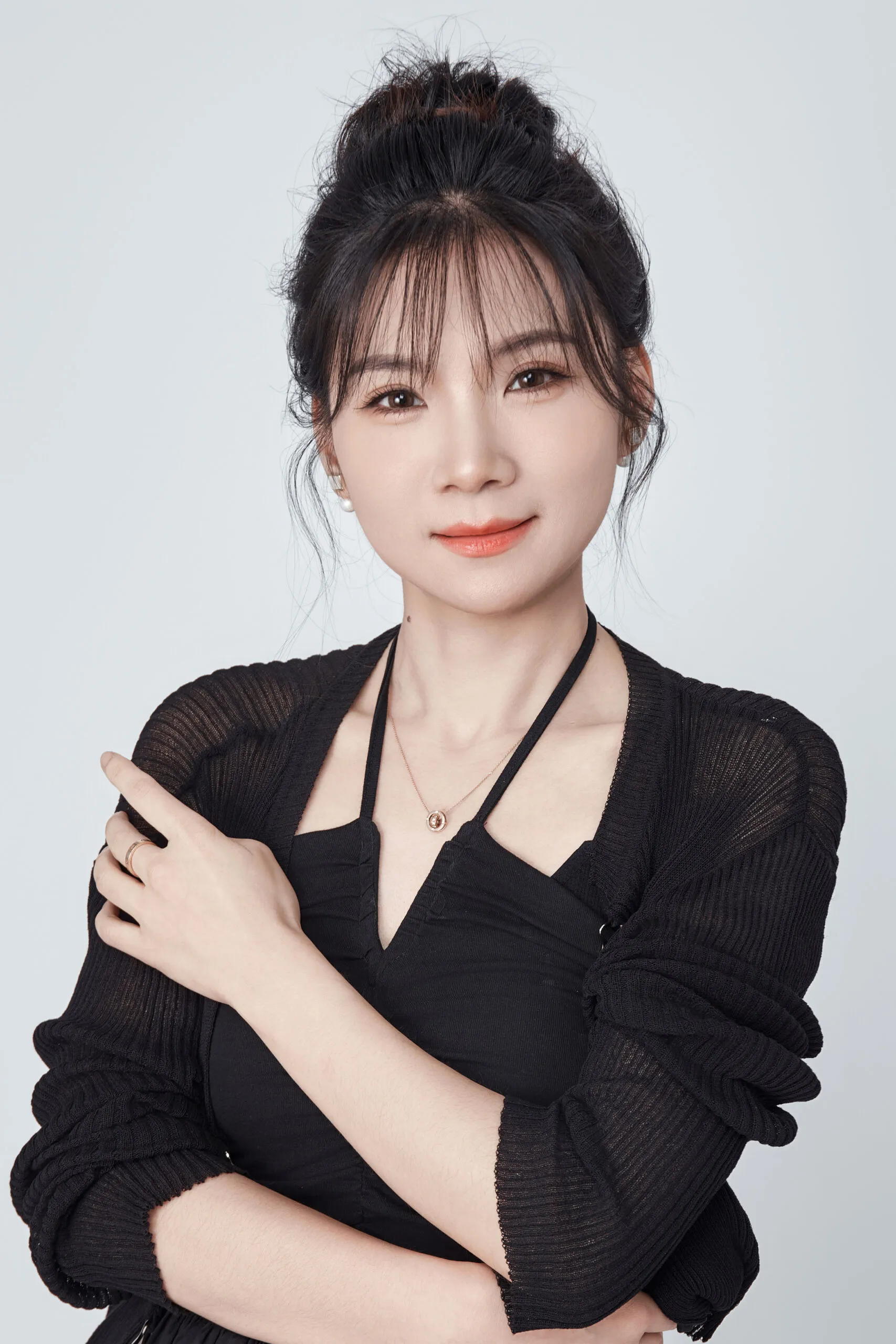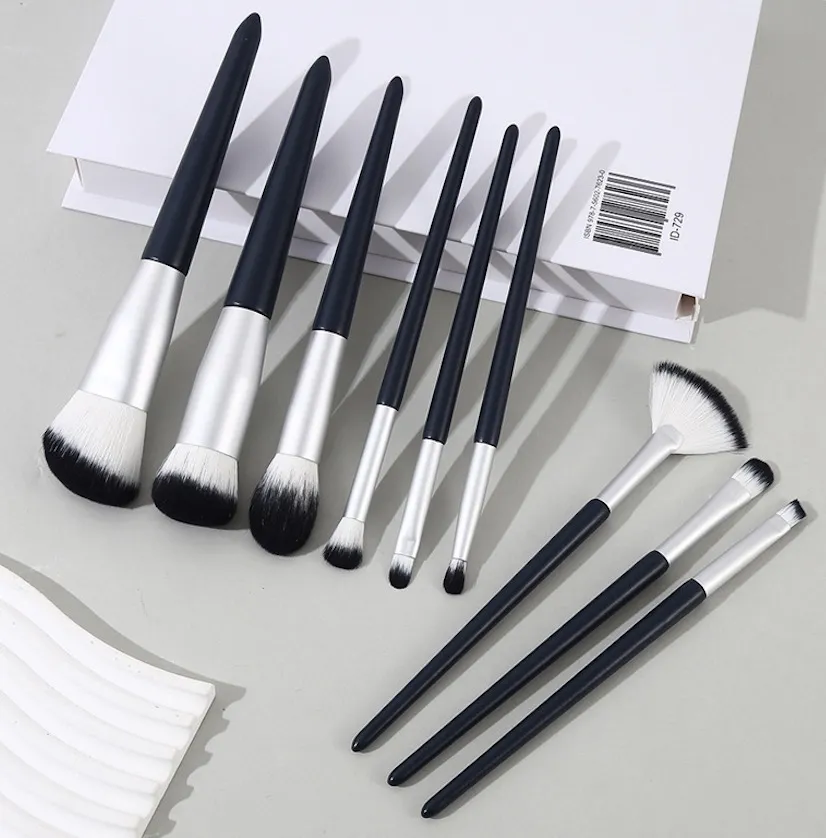Choosing the wrong brush bristle can waste product and lead to bad reviews. Your brand’s reputation depends on getting this detail right, but the options feel overwhelming.
For liquid or cream formulas, choose synthetic brushes1. Their smooth PBT/PET fibers provide streak-free application without absorbing product. For powders, choose natural hair. Its microscopic scales grip and diffuse powders for a soft, blended finish. This is the fundamental rule for high-performance tools.

I’ve seen hundreds of brand founders struggle with this decision. They worry about performance, ethics, and cost. It feels like a choice where you can’t have it all. But after years of working on the factory floor and now running my own OEM business, I can tell you it’s simpler than it seems. You just need to connect your product’s formula and your brand’s values to the right material science. Let’s break down the technical details so you can source your next brush line with total confidence.
The global makeup brush market is projected to reach nearly $12.9 billion by 2034.True
Market analysis from multiple sources indicates a CAGR of around 6.3%, driven by the rising adoption of synthetic and cruelty-free tools.
Powder vs. Liquid: Which bristle type actually performs better and why?
Your foundation is streaky, or your eyeshadow isn’t blending. The problem might be your bristle choice. Using the wrong brush wastes product and creates a poor user experience.
The answer lies in the bristle’s structure. Natural hair has a cuticle layer with tiny scales that grab powder. Synthetic fibers are smooth and non-porous, so they don’t soak up liquids. This is why the classic rule—natural for powder, synthetic for liquid—works so well.
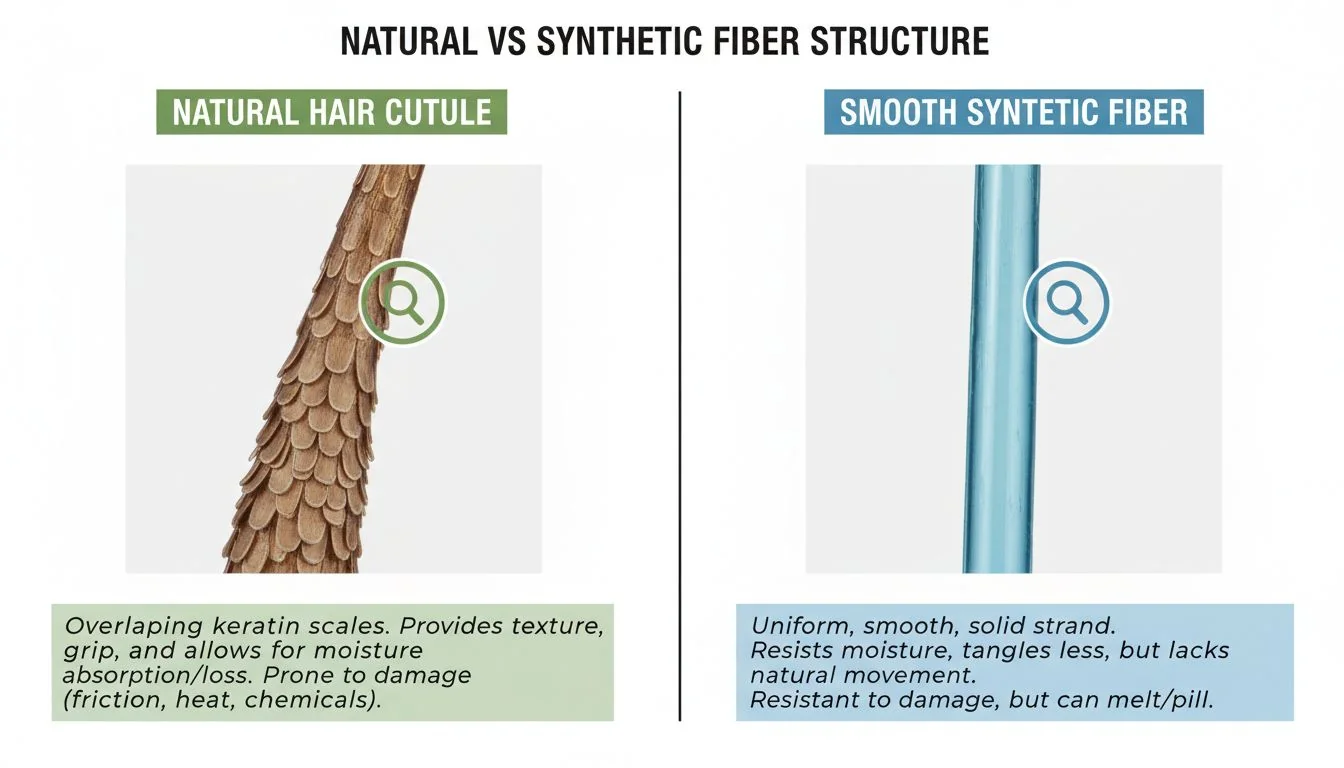
When I work with clients, this is the first thing we discuss. It’s the foundation of a great brush. The material science directly impacts the final look on the skin. Natural hair’s ability to pick up and diffuse loose particles is perfect for creating soft, airbrushed effects with blush, bronzer, and setting powder. The cuticles hold the powder until you press it onto the skin, allowing for a gradual, even release.
On the other hand, synthetic fibers are perfect for liquids and creams. Because they are non-porous, they don’t absorb the product. This means more foundation on the face and less wasted in the brush. The smooth surface allows you to glide and stipple the product for a seamless, high-coverage finish without any streaks. It also makes the brushes much easier to clean, which is a huge plus for hygiene.
All natural hair brushes are better than synthetic brushes.False
Performance depends on the makeup formula. Synthetics are superior for applying liquid and cream products because they don't absorb makeup, ensuring a smoother finish and less product waste.
What fiber specs matter: diameter, curvature, and polymer type explained?
You’ve been told a brush is "soft," but what does that mean technically? Sourcing without knowing the specs is a gamble. You could end up with a brush that feels scratchy or doesn’t perform.
Key specs determine a brush’s feel and function. fiber diameter2 controls softness and firmness. Curvature affects powder pickup. And the polymer type, like PBT or PET, dictates resilience and durability. Understanding these helps you brief your manufacturer precisely for the performance you need.
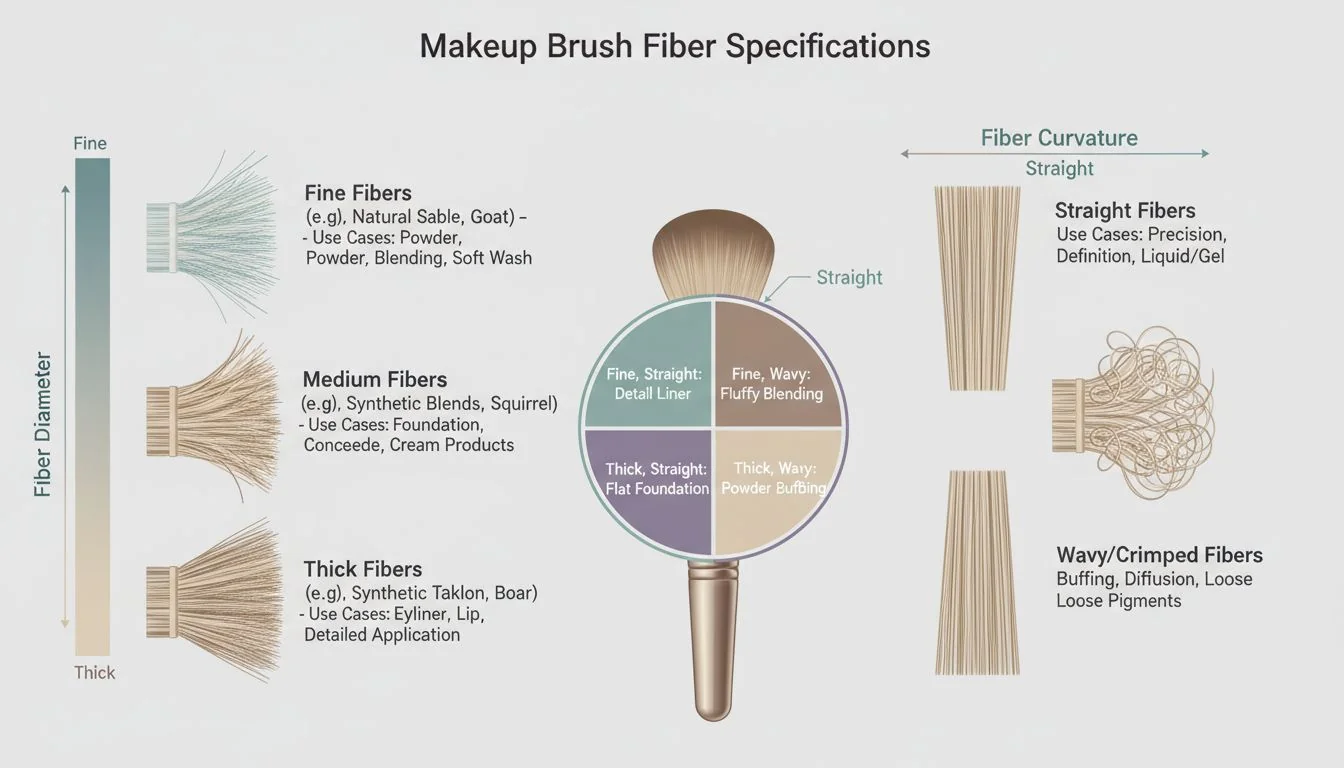
When I develop a new brush line with a brand, we don’t just talk about "softness." We talk in numbers. This is how you get consistent quality. Here’s a simple guide to help you spec your next brush.
Fiber Diameter
This is measured in millimeters and is the single biggest factor in how a brush feels.
- ~0.07 mm: This is a common diameter for soft, fluffy brushes. It’s perfect for applying powder, blush, and highlighter because the fine filaments provide a gentle, diffused application.
- ~0.10 mm: This thicker filament creates a firmer, more controlled brush. It’s ideal for precise tools like eyebrow brushes, lip brushes, and face mask applicators where you need to apply product with accuracy.
Fiber Curvature
This refers to the wave or crimp in the fiber.
- Waved/Curved Fibers: The waves create more surface area and little pockets, which dramatically improves how the brush picks up and holds onto powder products.
- Straight Fibers: These are better for precision. They provide a clean, sharp stroke, making them great for eyeliner, concealer, and other detailed work.
Polymer Type
Most modern synthetic brushes use PBT or PET.
- PBT (Polybutylene Terephthalate): This is my go-to for high-end synthetics. It’s incredibly soft, flexible, and resilient, meaning it holds its shape well after many washes.
- PET (Polyethylene Terephthalate): This is a very durable and cost-effective option. While it can be slightly stiffer than PBT, it’s a workhorse material for many brush types.
Here is a table to map these specs to common brush roles:
| Brush Role | Recommended Diameter | Recommended Curvature | Recommended Polymer |
|---|---|---|---|
| Foundation (Liquid) | 0.07 mm – 0.08 mm | Straight | PBT |
| Powder/Blush | ~0.07 mm | Waved | PBT |
| Eyeshadow Blending | ~0.07 mm | Waved | PBT |
| Eyebrow/Eyeliner | ~0.10 mm | Straight | PET or PBT |
| Face Mask Applicator | ~0.10 mm | Straight | PET |
A fiber diameter of 0.07 mm is best for firm, precise brushes like for eyebrows.False
A smaller diameter like 0.07 mm creates a softer, more diffuse application. Firmer, precise brushes for brows or lips typically use a thicker diameter, around 0.10 mm.
How do you ensure your brushes are ethical, hygienic, and sustainable?
Your customers demand cruelty-free products3, but you’re worried about greenwashing. Sourcing ethically and sustainably feels complex, with a risk of misleading claims and a lack of real certification from suppliers.
Focus on verifiable facts. Synthetic fibers are inherently cruelty-free. They are also more hygienic as they are non-porous and easier to sanitize. For sustainability, look for innovations like PCR-PBT and ask suppliers for compliance documents like REACH or ISO certifications.

This is a topic I’m very passionate about. Many of my clients, like Emily, build their brands on strong ethical values. They need a supply chain partner who understands and can deliver on these promises.
Ethics and Cruelty-Free Claims
The shift toward synthetic brushes is huge, driven by consumer demand for vegan and cruelty-free products.
- Synthetics: By definition, synthetic fibers like PBT and PET are 100% vegan and cruelty-free. This is the safest and clearest path for brands focused on this message.
- Natural Hair: If you choose natural hair, it’s critical to ask about sourcing. Terms like "cruelty-free goat hair" often mean the hair is a byproduct of the meat industry or collected during shedding seasons. You must get clear documentation from your supplier.
Hygiene and Maintenance
This is a major performance advantage for synthetics.
- Synthetics: Their non-porous fibers don’t trap bacteria, dead skin, or makeup. They can be washed frequently with stronger cleansers without getting damaged, making them ideal for professional MUAs and hygiene-conscious consumers.
- Natural Hair: The porous cuticles that are great for powders can also trap residue. They require gentle cleansers and careful drying to prevent bacteria growth and damage to the hairs.
Sustainability Innovations
The industry is moving beyond just "vegan."
- PCR-PBT: This stands for Post-Consumer Recycled PBT. It’s made from recycled plastics, reducing landfill waste and the need for virgin materials. It’s a fantastic story for eco-conscious brands.
- Antibacterial Treatments: Some synthetic fibers can be treated with agents like bamboo charcoal to inhibit bacteria growth, enhancing the brush’s hygiene.
- Compliance: Always ask for documentation. Certifications like REACH (for chemical safety in the EU) and ISO (for quality management) show that a factory is serious about its standards.
Synthetic brushes are harder to clean than natural brushes.False
Synthetics are non-porous and resist product absorption, making them significantly easier to clean and sanitize. Natural hair's cuticles can trap product and bacteria.
What’s my procurement playbook for sourcing brushes in 2025?
You’re ready to place an order, but you fear the risks. Delayed shipments, inconsistent quality, and low MOQs being ignored by big factories are common pain points that can kill a product launch.
Create a clear procurement plan. Define your Quality Assurance (QA) tests upfront. Understand market trends to inform your choices. And partner with a manufacturer who respects your brand’s scale, offering reasonable MOQs and transparent lead times.
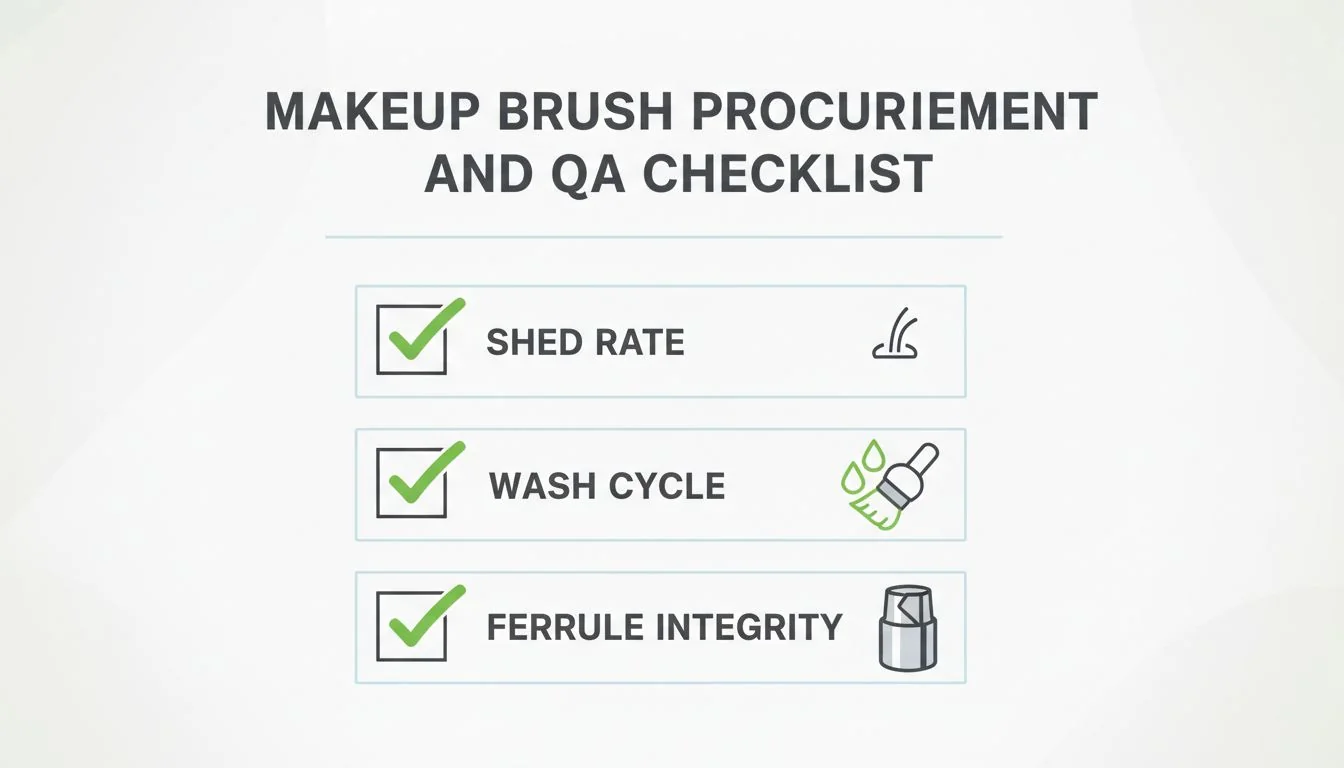
I built my business to solve these exact problems for founders. Having seen the process from both sides, I know that a good manufacturing partner acts as an extension of your team. Here is the playbook I share with my clients to ensure a smooth and successful production run.
Market Demand Trends for 2025
The data is clear: the market is growing, and consumer preferences are shifting.
- Market Growth: The makeup tools market is expanding at a CAGR of ~6.3%. This is a healthy, growing category.
- Synthetic Dominance: The strongest trend is the move to synthetic, cruelty-free brushes. This is no longer a niche; it’s the mainstream expectation, especially in US and EU markets. Your product assortment should reflect this.
Quality Assurance (QA) Testing
Don’t just ask for a sample; define your testing protocols.
- Shed Rate Test: Specify an acceptable level of shedding for a new brush.
- Wash-Cycle Retention: How does the brush hold up after 50 or 100 washes? The filaments should remain intact, and the ferrule (the metal part) should not loosen.
- Ferrule Integrity: Test the glue and crimping that holds the brush head to the handle.
- Specification Verification: For synthetics, confirm the polymer type4 and that the fiber diameter is within your agreed tolerance.
Logistics: MOQ, Lead Times, and Scaling
This is where many small brands get stuck.
- MOQ (Minimum Order Quantity): I started Brushino to offer low MOQs because I know big factories often ignore indie brands. Find a partner who can support your initial launch and scale with you.
- Lead Times: Be realistic. Synthetic fiber production is generally faster and more consistent than sourcing rare natural hairs. Plan your launch calendar with a 4-6 week buffer for production and shipping. A good partner will give you a transparent timeline and stick to it.
The makeup brush market is shrinking due to a decline in makeup use.False
The global makeup brush and tools market was valued at approximately 7.0 billion USD in 2024 and is projected to grow, not shrink.
Conclusion
Choosing between synthetic and natural brushes is simple: align the material with your product formula, brand ethics, and customer expectations. This data-driven approach ensures high performance and brand integrity.
References
-
Explore the advantages of synthetic brushes for makeup application, including performance and hygiene. ↩
-
Learn how fiber diameter influences the feel and function of makeup brushes. ↩
-
Find out how to ensure your makeup brushes are ethically sourced and cruelty-free. ↩
-
Understand the differences between polymer types like PBT and PET for brush durability. ↩

